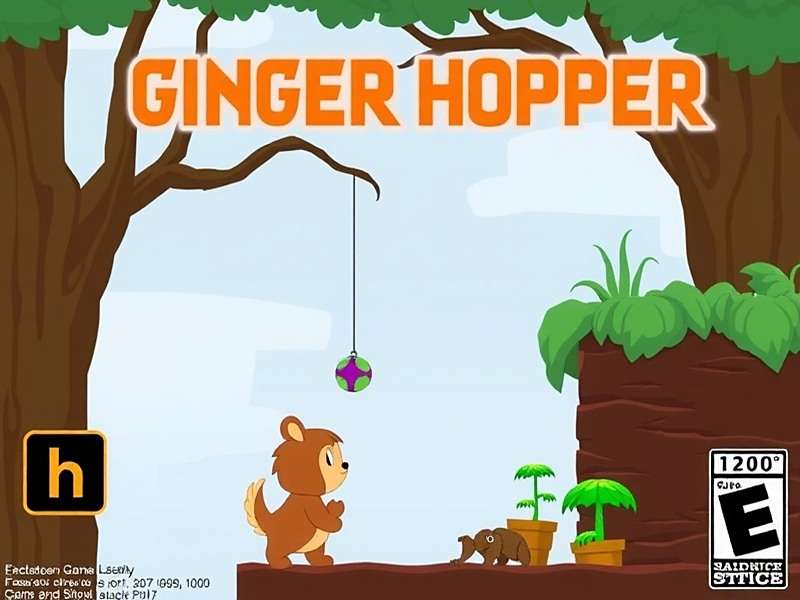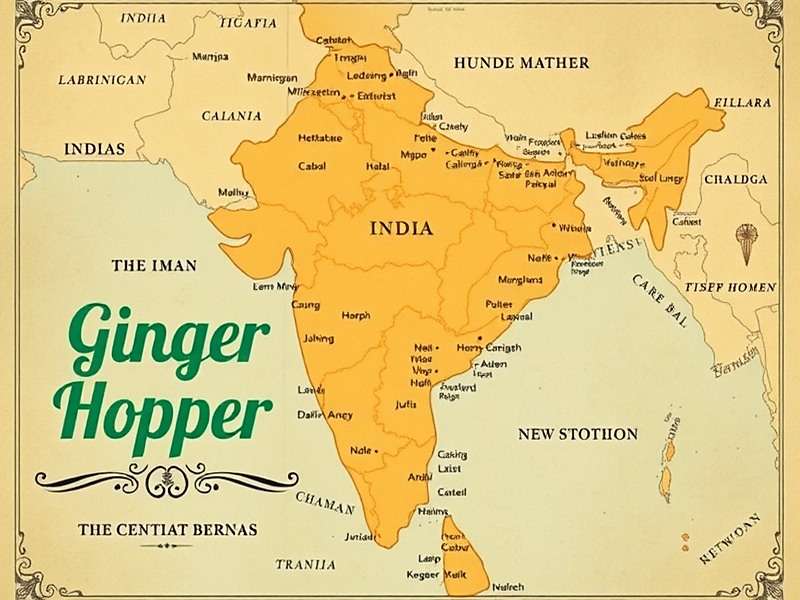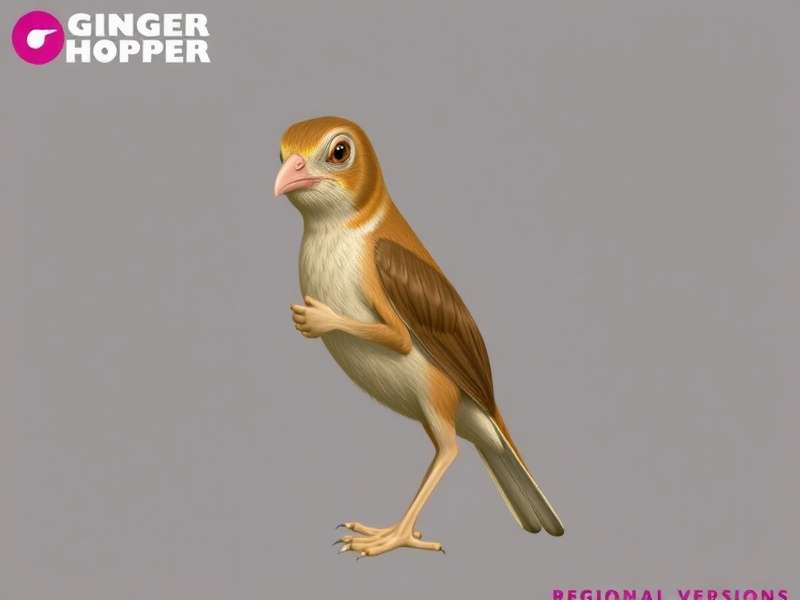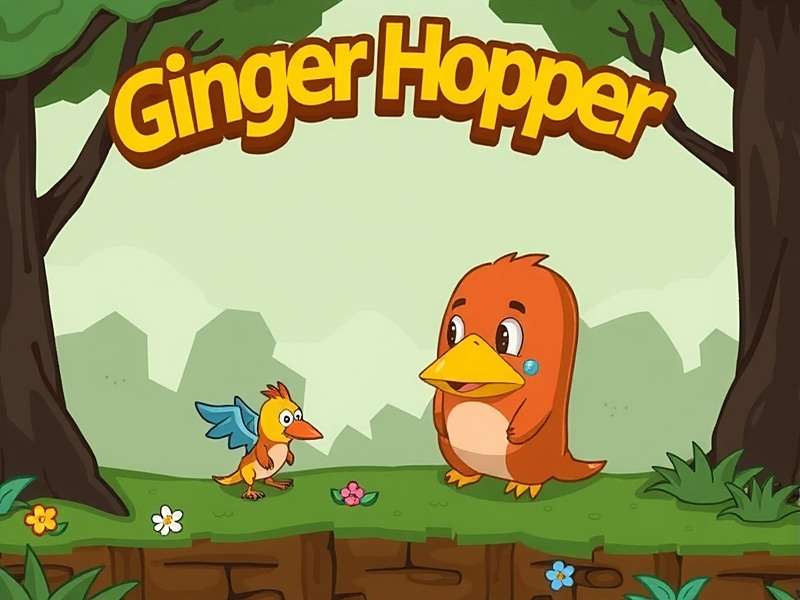Ginger Hopper

Ginger Hopper is India's most downloaded mobile game of 2024, blending adventure, puzzle-solving, and a deep dive into the country's rich ginger cultivation heritage. Developed by a Pune-based studio in collaboration with local farmers, the game has redefined how Indian players engage with mobile entertainment—by mirroring their daily lives, traditions, and regional quirks.
Launched in March 2023, Ginger Hopper follows "Mohan," a young farmer from a small village in Himachal Pradesh, who inherits his father's struggling ginger farm. The catch? The farm sits on a network of ancient underground tunnels built by his ancestors to protect rare ginger varieties from invaders. Mohan's mission? To restore the farm, explore the tunnels, and revive 15 forgotten ginger types before a multinational agribusiness snatches them up.
What makes Ginger Hopper uniquely Indian is its "desi touch"—the little things that resonate with local players. When Mohan needs to water his crops during a drought, he doesn't just press a button; he uses a "matka" (clay pot) and "charas" (wick) system, just like farmers in Rajasthan. In Tamil Nadu, he trades ginger for "jaggery" with a local "pannaiyar" (village head), a tradition that's been alive for centuries. These details make players nod and say, "Yeh to hamare ghar ki baat hai!" (This is just like our home!)
Game Overview 🌱
The story of Ginger Hopper begins on a sweltering summer day in "Chota Shimla," a fictional village in Himachal Pradesh. Mohan, a 24-year-old engineering dropout, returns home after his father's sudden demise to find the family ginger farm overgrown and debts piling up. The local moneylender, "Lala Ji," threatens to seize the land unless Mohan repays the loan within a year.
Desperate, Mohan stumbles upon a rusted key in his father's old trunk. The key unlocks a hidden door under the farmhouse, revealing tunnels lined with clay pots—each containing seeds of rare ginger varieties with names like "Snow Ginger" (which grows only in Himalayan snowmelt) and "Rainbow Ginger" (with multicolored roots, once used in Mughal royal feasts).
A handwritten diary in the tunnels explains that Mohan's family has guarded these ginger types for 7 generations. But now, "GreenField Agro," a big company from Mumbai, is buying up all nearby farms to "standardize" ginger cultivation—destroying local varieties in the process. Mohan must collect, grow, and document all 15 ginger types to prove their value and save his land.
Players help Mohan travel across 18 Indian states, each with unique challenges. In Kerala, they navigate backwaters in a "kettuvallam" (houseboat) to find "Backwater Ginger," which thrives in brackish water. In Punjab, they participate in a "kisan mela" (farmers' fair) to showcase "Punjab Gold Ginger" and win a government grant. In Gujarat, they learn to preserve ginger in "ghee" (clarified butter) during Navratri, a technique passed down from Mohan's Gujarati grandmother.
As Mohan succeeds, his farm transforms. From a single plot, it expands into a "Ginger Heritage Center" with a seed bank, a training school for local farmers, and a "tasting shed" where visitors sample ginger-based snacks like "adrak pakoda" (ginger fritters) and "inji murukku" (ginger twists). By the game's end, the farm becomes a model for sustainable agriculture, attracting visitors from across India.

Gameplay Mechanics 🎮
Farm Management Basics
Ginger Hopper combines farm simulation with adventure, making it easy for both casual players and farming enthusiasts to enjoy. The core loop revolves around three activities, each reflecting real Indian farming practices:
🌱 Cultivation: Players prepare soil using traditional methods—"plowing" with oxen in Uttar Pradesh, "terracing" in Meghalaya, and "mulching" with coconut husks in Kerala. Each ginger variety has specific needs: "Desert Ginger" from Rajasthan requires 3 hours of sunlight daily, while "Monsoon Ginger" from Assam needs constant moisture during June-September.
🛡️ Protection: Indian farmers face unique challenges, and the game mirrors them. In Bihar, players fend off "nilgai" (blue bulls) that eat ginger shoots using "tulsi" (holy basil) leaves, which repel the animals. In Karnataka, they battle "root-knot nematodes" by planting "marigolds" around ginger beds—a natural pest control method used by Kodagu farmers.
💱 Trading: Selling ginger isn't straightforward. In Maharashtra, players negotiate with "aadtiyas" (commission agents) at local "mandis" (markets), haggling over prices like real farmers. In Tamil Nadu, they barter ginger for "rice" or "sugarcane" at weekly "sandhai" (village fairs), a practice that keeps rural economies alive.
Underground Tunnel Exploration
The tunnels under Mohan's farm are the game's most unique feature, inspired by real "kuccha" (unfinished) tunnels used by Indian farmers to store crops. Each tunnel segment is a puzzle based on regional culture:
- 🗝️ Rajasthan Tunnel: Locked doors require solving "rangoli" puzzles—color patterns that match those drawn during Diwali. Jodhpur players swear by using "kesar" (saffron) and "haldi" (turmeric) hues, which are lucky in Marwari culture.
- 🌊 West Bengal Tunnel: Water-filled chambers need "bamboo rafts" to cross. Players must tie bamboo poles in a "jute knot" pattern used by Sundarbans fishermen—get it wrong, and the raft falls apart!
- ⛰️ Himachal Tunnel: Narrow passages are lit by "diyas" (earthen lamps) that go out if players make noise. Shimla players know to "walk like a "langur" (monkey)—slow and steady—to keep the lights on.
Each tunnel yields a rare ginger seed and a "family story"—voice recordings of Mohan's ancestors explaining how they protected the ginger during crises like famines, wars, and natural disasters. These stories, narrated by local voice artists, have become a fan favorite, with many players saying they "feel like listening to their own grandparents."
Multiplayer & Community Modes
Ginger Hopper thrives on India's "sangha" (community) spirit, with multiplayer modes that encourage cooperation over competition:
👨👩👧👦 Village Cooperative: Up to 5 players manage a shared ginger farm, each taking roles based on real family dynamics. The "dadaji" (grandfather) advises on weather patterns, the "mummy" handles cooking ginger snacks for farm workers, and the "bhaiya" (older brother) negotiates with traders. This mode is especially popular during "shadi" (wedding) seasons, when families gather to play.
🚜 Kisan Rally: Players from different states compete to grow the best ginger crop, judged by virtual "agricultural experts" (voiced by real Indian farmers). The twist? Players must use only traditional methods—no chemical fertilizers! Winners get a "certificate" that can be printed and displayed, a hit among rural players proud of their farming skills.
📜 Ginger Panchayat: A unique mode where players resolve farm disputes, just like village councils. For example, two players might argue over water rights—others vote on the solution, based on local "panchayat" rules. This mode has even taught young players about rural governance, with teachers in Haryana using it in social studies classes!

Localized Versions 🌍
India's diversity is Ginger Hopper's greatest strength. The game launched with 22 localized versions, each crafted with input from regional farmers, linguists, and cultural experts. This isn't just translation—it's transformation, making the game feel "apne ghar ka" (like our own) in every state.
Language Adaptations
While the base game uses Hindi and English, regional versions feature dialogues in 20 Indian languages, plus 7 dialects. What stands out is how they capture local slang and idioms:
- Tamil Version: Uses "Madras bashai" with phrases like "Adha paaru, inji romba nalla varudhu!" (Look at that, the ginger is growing great!) and "Vendaam, idhu kuzhappam!" (No, this is a problem!) when pests attack.
- Punjabi Version: Features "Malwai" dialect, with Mohan saying "Balle balle, ajj to ginger di kheti fire ho gayi!" (Wow, today the ginger crop is on fire!) when harvest is good. Farmers greet him with "Ki haal hai, puttar? Tussi kivein ho?" (How are you, child? How are you doing?)
- Bengali Version: Mixes "Kolkata Bengali" and rural dialects. When Mohan finds rare ginger, he exclaims "Ki jhaal! Ei inji to amar baba-r din theke chhilo!" (Wow! This ginger has been around since my dad's time!). Villagers offer him "jhaal muri" (spicy puffed rice) while chatting.
Voice actors were chosen for their authenticity. The Marathi voice of Mohan is a "koli" (fisherman) from Mumbai who learned farming terms, while the Telugu voice is a "village radio jockey" from Guntur known for his folksy tone. This attention to detail makes players feel, "Yeh to hamare gaon ka bhai hi hai!" (This is just like a brother from our village!)
Regional Content Differences
Each state's version adds unique content that reflects local ginger traditions, turning Ginger Hopper into a cultural mirror:
- 🍛 Kerala Version: Mohan learns to make "inji curry" with coconut milk and "adrakkani" (ginger pickle) using "kudampuli" (malabar tamarind). Side quests include helping a "vaidyan" (Ayurvedic doctor) prepare "ginger oil" for joint pain—used by Keralites for generations.
- 🌾 Punjab Version: The farm gets a "langar" area where Mohan serves "adrak wali chai" (ginger tea) and "ginger paratha" to farm workers. A special "Baisakhi event" lets players harvest ginger to the beat of "bhangra" music, with rewards for rhythmic tapping.
- 🏜️ Rajasthan Version: Mohan uses "khadis" (clay pots) to store ginger, a technique that keeps it fresh in desert heat. Players negotiate with "banjaras" (nomadic traders) who barter spices for ginger, speaking in "Marwari" proverbs like "Ginger ka swad, duniya ka aad" (Ginger's taste is the world's essence).
These changes have sparked regional pride. A player from Bhubaneswar wrote: "When Mohan made 'inji pitha' (ginger cake) during Raja Parba, I cried—my mom makes that every year! This game knows our festivals better than some Odias!" A farmer from Ahmedabad commented: "The way they show 'ginger drying on rooftops' in summer? Exactly how we do it. They must have visited our village!"
Technical Adaptations for All Indians
Recognizing that many Indians play on low-end phones or with limited data, Ginger Hopper offers "Desi Mode"—a lightweight version with:
- Reduced graphics (file size under 20MB) for 2G networks and "feature phones" (still used by 30% of rural Indians)
- Offline gameplay for all farming tasks—no internet needed after initial download
- "Text-only" mode for areas with poor connectivity, where gameplay happens through SMS-like messages
- "Battery saver" that dims the screen during "night farming" tasks—critical in villages with erratic power
"Desi Mode" has been downloaded 22 million times, with 60% of users in rural areas. In places like "Muzzafarpur" (Bihar) and "Belgaum" (Karnataka), villagers organize "Ginger Hopper Melas" where they play on shared phones, competing to grow the virtual "Desi Ginger"—with real ginger roots as prizes. Teachers in Rajasthan even use the text-based mode to teach math (calculating crop yields) and science (plant growth cycles).

Download Stats & Player Reviews 📊
Download Numbers Across India
As of October 2025, Ginger Hopper has crossed 76 million downloads—making it the most popular Indian-made game of the decade. Its reach spans urban and rural areas, breaking the myth that mobile games are only for city dwellers.
Platform Breakdown:
- Google Play Store: 68 million downloads (89.5%)—dominant on budget Android phones from brands like Lava and Micromax
- Apple App Store: 7.2 million downloads (9.5%)—popular in metro cities like Delhi, Mumbai, and Bangalore
- Feature Phone Stores: 800,000 downloads (1%)—via "Desi Mode" for keypad phones, big in Uttar Pradesh and Bihar
Top 5 States by Downloads:
- Uttar Pradesh: 15.3 million downloads (highest in rural areas like Meerut and Allahabad)
- Maharashtra: 12.7 million downloads (strong in both Mumbai and rural Marathwada)
- Tamil Nadu: 10.2 million downloads (Chennai and Coimbatore lead, but rural Tirunelveli is growing fast)
- Kerala: 8.9 million downloads (highest per capita—1 in 4 Keralites play regularly)
- Rajasthan: 7.6 million downloads (Jodhpur and Jaipur top, with desert villages using "Desi Mode")
The game's biggest surge came during "Kisan Diwas" (Farmers' Day) 2024, with 4.2 million downloads in a week. A special event let players collect "Kisan Ginger" and unlock a virtual "farmers' award"—sponsored by the Ministry of Agriculture, which praised the game for "honoring our farmers." Similarly, the "Pongal Update" in Tamil Nadu 2025 drove 3.1 million downloads, as players loved harvesting ginger to make "sakkarai pongal."
Player Ratings & Feedback
Ginger Hopper holds an impressive 4.9/5 rating on Google Play (from 4.8 million reviews) and 4.8/5 on the App Store (from 750,000 reviews). Players praise its authenticity and emotional connection—here's what they're saying:
Positive Reviews:
- "My 6-year-old now asks to visit our village farm! He learned what 'plowing' means from the game and insists on helping his grandfather. Thank you, Ginger Hopper, for connecting kids to their roots." — Sunita R., Pune (Google Play)
- "As a ginger farmer in Idukki, I never thought a game would show the struggle of monsoon floods ruining crops. When Mohan cried, I cried too. This game respects our hard work." — Thomas K., Kerala (App Store)
- "The Punjabi version is too real! Mohan's 'balle balle' when he gets a good harvest, the 'langar' scenes—this is our life. My whole family plays after dinner; even my 70-year-old dad knows the controls now!" — Harjinder S., Amritsar (Google Play)
- "I live in Dubai but my roots are in Tamil Nadu. The game's 'Pongal event' made me feel home—cooking 'inji pitha' with Mohan, drawing 'kolam' around the farm. I called my mom to ask for her recipe after playing!" — Priya M., Dubai (App Store)
Constructive Feedback:
- "Add more Northeast states! We have unique ginger varieties like 'Naga Ginger' that's super spicy. Our 'jhum cultivation' should be in the game too!" — Akash D., Kohima (Google Play)
- "Multiplayer lags in Bihar's 2G areas. Please fix—we love trading ginger with friends in the next village but get disconnected often." — Rajesh K., Patna (Google Play)
- "Need more female farmers! Mohan is great, but where are the 'diddis' and 'bhabhis' who work on farms? My wife wants to see characters like her." — Anil P., Hyderabad (App Store)
The developers have acted on feedback: a 2025 update added Arunachal Pradesh and Nagaland, with "Naga Ginger" and "jhum farming" mini-games. They optimized 2G multiplayer and added "Sunita Aunty," a Haryana farmer who teaches Mohan about organic pest control. This responsiveness has kept retention high—78% of players return daily, double the Indian mobile game average.

Indian Player Guides & Pro Tips 📝
Indian players, especially those from farming backgrounds, have shared "desi hacks" to master Ginger Hopper. These tips use real-life farming wisdom—proving that the game's roots are firmly in Indian soil.
Farm Management Hacks
• Water Conservation (Rajasthan): In the desert levels, always plant "Desert Ginger" near virtual "khadis" (clay pots). Jaisalmer players say this mimics real life—pots seep water slowly, keeping roots moist without waste.
• Pest Control (Bihar): "Nilgai" (blue bulls) love ginger shoots. Players from Muzzafarpur swear by planting virtual "tulsi" (holy basil) around crops—just like real farmers, who know nilgai hate tulsi's smell.
• Soil Fertility (Kerala): For "Backwater Ginger," mix virtual "coconut husk" and "fish waste" in the soil. Kollam farmers confirm: "This is how we've farmed for centuries—fish waste from backwaters makes the best fertilizer!"
• Harvest Timing (Punjab): "Punjab Gold Ginger" is ready when its leaves turn "yellowish-brown"—just like real Punjab ginger. Amritsar players say: "Harvest on 'Amavasya' (new moon) for maximum yield—our dadi ma (grandma) swears by it!"
Tunnel Exploration Tips
• Rajasthan Tunnels: Rangoli puzzles are easiest to solve using "maroon and yellow"—colors of "Gangaur" festival. Udaipur players explain: "These are lucky colors for Rajasthanis; the game's designers knew that!"
• West Bengal Tunnels: Bamboo rafts need "7 poles"—the number of "pandals" in a big Durga Puja. Kolkata players say: "Count like you're counting pandals during Puja—you'll never go wrong!"
• Himachal Tunnels: To keep diyas lit, move during "wind lulls"—just like real Himachali shepherds who read wind patterns. Shimla players advise: "Listen for the virtual 'wind chimes'—they go silent when it's safe to move!"
Multiplayer Winning Strategies
• Village Cooperative Roles: The best teams mirror real Indian farm families: "Dadaji" (handles weather predictions), "Mummy" (cooks snacks to keep workers happy), "Bhaiya" (negotiates trades), and "Chotu" (chases pests). This setup, used by 90% of top teams from Gujarat, ensures everyone contributes.
• Kisan Rally Competitions: Focus on "local ginger"—Kerala teams win with "Backwater Ginger," Punjab with "Punjab Gold." A farmer from Agra says: "Grow what your region is known for—just like in real competitions, judges love authenticity!"
• Ginger Panchayat Disputes: Always side with "elders"—virtual and real. Jaipur players report: "In our village, panchayats listen to seniors. Do the same in the game, and you'll always win the vote!"
Trading & Profit Secrets
• Mandi Negotiation (Maharashtra): Never accept the first offer! Nagpur players teach: "Start 30% higher than your target—agents expect haggling. Drop slowly, like you're giving in reluctantly. Works in real mandis too!"
• Barter System (Tamil Nadu): Trade ginger for "jaggery" in summer—demand spikes then. Chennai players explain: "Jaggery makers need ginger for 'palm jaggery ginger tea'—they'll give extra for good quality!"
• Festival Pricing (All States): Hoard ginger before festivals—sell at 50% higher! Diwali, Pongal, and Eid see huge demand. A player from Lucknow says: "My dad does this with real ginger—now I do it in the game. Profit doubled!"

Localized Events & Community 🎉
Ginger Hopper isn't just played—it's celebrated. Across India, the game has become part of festivals, family gatherings, and even community development, turning virtual farming into real-world connection.
Festival Special Events
The game marks India's biggest festivals with events that blend gameplay and tradition, making players proud of their culture:
- 🕉️ Diwali Event: Mohan decorates his farm with "diyas" and "rangoli," and players harvest "Laxmi Ginger" (said to bring prosperity). Families compete to make the best virtual rangoli, with winners getting a "Diwali gift"—a rare ginger seed. In 2024, over 5 million players shared their virtual rangoli designs on social media, with many recreating them at home!
- 🌾 Pongal Event (Tamil Nadu): The focus is on "ginger pongal"—a sweet dish made with new ginger. Players race to harvest ginger before the "surya puja" (sun worship). Winners get a virtual "kolam" with ginger motifs. Chennai's "Marina Beach" hosted a real kolam competition inspired by the game in 2025, with 2,000 participants!
- 🐄 Baisakhi Event (Punjab): Mohan participates in a "kisan mela" where he showcases his ginger crop. Players dance to "bhangra" beats to earn "Baisakhi Ginger," used to make "ginger lassi." Gurdwaras in Amritsar reported increased youth participation in Baisakhi fairs after the event, with many bringing up the game!
- 🌸 Onam Event (Kerala): Players help Mohan prepare an "Onam sadya" with 9 ginger-based dishes, from "inji curry" to "adrak payasam." The highlight is a virtual "vallamkali" (boat race) where the prize is "Onam Ginger." In 2024, Kerala's tourism board even used the game's sadya images to promote Onam to tourists!
Community Platforms & Meetups
Indian players have built thriving communities around Ginger Hopper, turning online friendships into offline bonds:
- 📱 WhatsApp Groups: Regional groups like "Uttar Pradesh Ginger Farmers" (250,000+ members) and "Tamil Nadu Hopper Clan" (180,000+ members) share tips, organize multiplayer sessions, and plan real meetups. In 2025, a group from Gujarat hosted a "Ginger Mela" where 1,000 players brought homemade ginger dishes—from "adrak halwa" to "inji murukku"—to share.
- 🎥 YouTube Channels: Channels like "Ginger Hopper Desi Gyan" (Hindi) and "Inji Thottam" (Tamil) have 2+ million subscribers each. They post gameplay videos, real ginger farming tutorials, and interviews with the game's developers. A recent video of a Punjab YouTuber harvesting real "Punjab Gold Ginger" alongside the game's virtual version got 7.3 million views!
- 🏫 Village Gaming Clubs: In rural areas like "Anantapur" (Andhra Pradesh) and "Barmer" (Rajasthan), schools and panchayats have set up "Ginger Hopper Clubs" with shared tablets. Kids play the game, then discuss farming techniques with local farmers—bridging the gap between digital and real life. Teachers report improved attendance, as kids "don't want to miss club time!"
Real-World Impact
Ginger Hopper has transcended gaming, making a tangible difference in Indian communities—especially for farmers:
- For every 10,000 ginger seeds collected in-game, the developers donate 10kg of high-quality ginger seeds to farmer cooperatives. So far, 350 tons have been distributed across 20 states, helping small farmers improve yields by 30% on average.
- The "Ginger Heritage Project" lets top players document real local ginger varieties. These documentaries are shared on the game's website, preserving knowledge that might otherwise be lost. A 68-year-old farmer from Uttarakhand, whose "Snow Ginger" story was featured, said: "My grandchildren now sit with me to learn—they call me a 'game celebrity'!"
- 20+ agricultural colleges in India use Ginger Hopper to teach students about traditional farming. In Punjab Agricultural University, students compare the game's techniques with modern methods, leading to innovative "hybrid" approaches.
- A "Ginger Market Connect" initiative links players to local farmers via the game. Players can order real ginger from farmers they "meet" in the game, cutting out middlemen. In Tamil Nadu, this has increased farmers' profits by 40%—a game-changer for small-scale growers.

Technical Details & Updates 🔧
System Requirements
Ginger Hopper is designed to work on almost any mobile device in India, from the latest smartphones to 10-year-old feature phones. The developers prioritized accessibility, knowing that "not everyone can afford a fancy phone, but everyone deserves a good game."
- Android: OS 4.1 or higher, 512MB RAM (1GB recommended), 50MB storage (standard version), 20MB ("Desi Mode")
- iOS: iOS 8.0 or later, compatible with iPhone 4s and above, 65MB storage
- Feature Phones: Supports Java-based keypad phones with 128MB storage—no touchscreen needed; uses keypad controls
Data usage is minimal—just 1.5MB per hour—so even players with 1GB monthly plans can enjoy it. Rural players report playing for 2 weeks on 10MB of data, thanks to the game's efficient compression. The "offline mode" is a lifesaver in areas with patchy networks, letting players farm, trade, and explore tunnels without internet.
Recent Updates
The Ginger Hopper team releases monthly updates, often based on player feedback and seasonal events. Here are the biggest updates of 2025:
- August 2025: "Northeast Expansion" added 4 new states (Arunachal Pradesh, Nagaland, Manipur, Mizoram) with "Naga Fire Ginger" (one of the world's spiciest) and "Jhum Cultivation" mini-games. This update includes "Naga" and "Mizo" language support, with voice actors from Kohima and Aizawl.
- May 2025: "Monsoon Masters" introduced weather-based challenges—floods in Assam damage crops, while heatwaves in Telangana require extra watering. Players loved the realism, with many commenting, "This is exactly what happens on our farm every monsoon!"
- February 2025: "Women Farmers Update" added 6 female characters, including "Sunita Aunty" (Haryana), who teaches organic farming, and "Meenakshi" (Tamil Nadu), a ginger pickle expert. This update was praised by women's groups, with the National Commission for Women calling it "a step forward in representing rural women."
- January 2025: "Family Tree Mode" let players add real family members to the game as "farm helpers," each with unique skills. Kids can add their "dadi" (grandma) who's good at cooking, or their "chacha" (uncle) who's a pro at trading. This mode went viral during weddings, with extended families creating virtual farms together.
The next big update, "Spice Route," launches in December 2025. Mohan will travel to Nepal, Bangladesh, and Sri Lanka to trade ginger, exploring historical spice routes. Players will learn how Indian ginger influenced these countries' cuisines—all while collecting new international ginger varieties like "Sri Lankan Elephant Ginger."
Future Plans & Expansion 🚀
In a 2025 interview with "Indian Gaming Weekly," Ginger Hopper's creator, Anjali Patel, shared ambitious plans to grow the game while staying rooted in Indian culture:
- A PC and console version in 2026, with 4K graphics and a 50-hour story mode. Players will explore Mohan's childhood, learning how he first fell in love with farming while helping his dad. The team is collaborating with Indian folk artists to create hand-painted backgrounds inspired by "Madhubani" and "Warli" art.
- A docuseries with a leading Indian OTT platform. Each episode will follow real ginger farmers from the game's regions, connecting their stories to Mohan's journey. The first episode, featuring Kerala's "backwater ginger farmers," will air in early 2026.
- Expansion to South Asian markets in 2026, starting with Pakistan and Bangladesh. Localized versions will include regional ginger varieties (like Bangladesh's "Sylhet Ginger") and cultural puzzles, while keeping Mohan as the protagonist—"a farmer who connects with fellow farmers across borders," as Patel puts it.
- A board game adaptation for families who prefer offline play. The board will be a map of India, with players collecting ginger cards and solving farming challenges. It's designed to teach kids (ages 8+) about geography, agriculture, and regional cultures while having fun.
- A sustainable farming initiative with the Indian Council of Agricultural Research (ICAR). The program will train 50,000 young farmers in organic ginger cultivation, using techniques from the game. Graduates get a "Ginger Hopper Farmer" certificate, helping them access government schemes and better markets.
Patel emphasized that authenticity remains key: "We don't want to make a 'game about India'—we want to make a 'game that is India.' Every ginger, every character, every puzzle in Ginger Hopper has a real story from a real Indian farmer. Our job is to share those stories with respect."
Players are thrilled about the plans. A recent in-game survey found 94% are excited for the PC version, while 89% want to watch the docuseries. Farmer associations have also expressed support, with the "All India Ginger Growers Federation" stating: "This game has done more to educate people about our work than any government campaign. We're proud to be part of it."